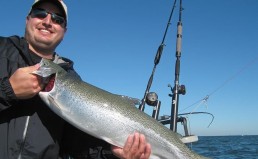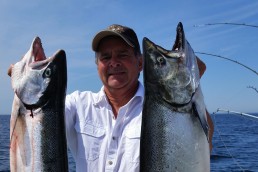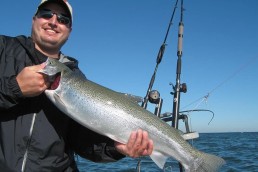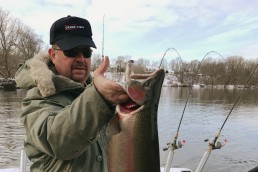Finding the Rainbow (or Steelhead) Connection
SHARE THIS POST
If you are like many people fishing Lake Michigan the last couple of years, your results for catching king salmon were far short of expectations. Stocking cutbacks mean there aren’t as many fish out there from hatchery sources. Poor spawning conditions in streams capable of producing wild fish means there aren’t as many available courtesy of Mother Nature. And based on the paltry spawning runs experienced up and down the lake, it appears many of the baby kings that did make it to the lake didn’t survive to maturity for a variety of reasons.
Is it time to put the ol’ Wavewhacker on the market and go golfing? Will you easily make the transition from being a king salmon fisherman to being a laker-taker?
Don’t overlook the rainbow connection.
Okay, maybe a better term would be the steelhead connection, but the Muppets never popularized a Paul Williams song by that name. Steelhead are technically rainbow trout, so there is a connection.
Most anglers with a modicum amount of fishing time on the Great Lakes have caught the occasional steelhead when trolling for salmon. A few of the southern ports get a reliable enough run of Skamania-strain steelies that target them for a week or two in the summer too. But how many anglers actually head out with a goal of connecting with steelheads often enough to make the trip worthwhile? Not many, but with the dearth of kings, the steelhead connection could be a viable alternative to scheduling tee times.
If you choose this route, key in on a few tricks to “up” your chances for success.
Are you enjoying this post?
You can be among the first to get the latest info on where to go, what to use and how to use it!
Out for trout
I once set lines a few miles offshore one morning and steered a heading directly away from land. I didn’t turn the boat for the next six hours. At the beginning of the trip, most of the fish caught were salmon. After an hour or so, the lake trout started coming to the party and a salmon or two. Then it became lake trout with a steelhead, but the last two hours saw steelhead after steelhead. It seemed the farther we went, the more steelhead we found. When I pulled lines and punched in the numbers, I was 28 miles offshore—I don’t think that you can go too far.
Speed kills
There are two reasons to troll fast: The fish like to bite fast-moving lures and you cover more water. I wrote an article several years ago about high-speed trolling on the Great Lakes—I’m talking six to eight mph, which is two to four times higher than normal. It worked, and I even caught a few “lazy” lakers at that speed, but the steelhead loved it. The hard part was finding or tuning lures that would troll at those speeds. Rebel Fastracs, small cut plugs and lipless crankbaits (Rat-L-Traps) did well.
Make a racket
Cordell Spots and Rat-L-Traps have long been steely-stoppers on my boat, along with Rattlin’ ThinFins, J-Plugs with rattles and other noisy lures. You don’t have to troll them at zing-zone speeds either. I “love ‘em” as much as the steelies, especially when one of the steelhead decides to make a last-second jump of 15 to 20 feet behind the boat. Not only is it spectacular, but you can also hear that lure making rattlesnake sounds.
Go hot or stay home
Want to pick a “best color” for your lures? Think hot (fluorescent) red. There’s no natural food in the Great Lakes of this color, but steelhead don’t care. If it’s hot red, they’ll smack it. When specifically targeting steelhead, every lure I deploy is predominantly—or totally—a fluorescent red. Sure, they’ll bite a blue/silver spoon or a green ladder-back plug, but that’s only because they saw it before they spotted the hot red lure nearby.
Topping out
I’ve caught goby-gulping steelhead 119 feet deep in 120 feet of water, proving the exception to the rule that steelhead are surface-oriented fish. Whether I’m fishing in 18 feet of water just off the pier heads, or in 180 feet of water 28 miles offshore, there will always be lures for them running just under the surface.
The rainbow connection, the steelhead connection—call it what you wish. I call it fun.
MWO
SHARE THIS POST
Did you enjoy this post?
You can be among the first to get the latest info on where to go, what to use and how to use it!
Mike Schoonveld
A passion for hunting, fishing, trapping and an outdoor lifestyle has been true north on Mike Schoonveld’s compass his whole life. One of the Midwest’s most prolific outdoor communicators, scores of his columns have been published in the pages of MidWest Outdoors since the first one appeared in 1987.



